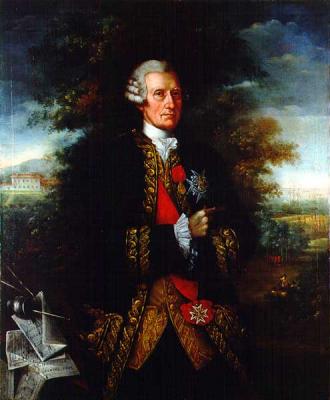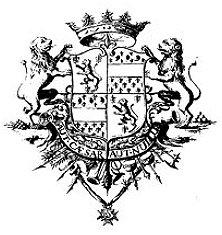
Charles Allen Du Val
His life and works
Richard Wall Du Val 1694-1777
A family related to the Wall family of Dunmoylan in Ireland, which had retained the old name Du Val, resided at Kilmallock, five miles from Limerick (1). Matthew Du Val, of that family, fought for King James II, but after the defeat at the Battle of the Boyne, he and his wife Catherine fled to France. Their son Richard Du Val (2) was born in Nantes on 5 November 1694 – an appropriate date, as he was to have a dazzling and meteoric career!

Richard Wall Du Val
Irish refugees and French nobility were then close allies, and young Richard Du Val became page to the Duchess of Vendome. He enrolled as midshipman in the Spanish navy as Ricardo Wall y Devereux, taking the Irish version of his surname and adding that of his mother in the Spanish fashion. After graduating as a naval cadet, he joined a seventy-four gun warship. However, suffering health problems through life at sea, he transferred to the Spanish army, serving first in the Hibernia Regiment from 1719 and then with the Batavia Dragoons from 1721.

After serving in several campaigns, in 1727 he travelled to Moscow with the Spanish ambassador, who thought him “a man in whom I put all my confidence, to whom I unburdened my heart in all my misfortunes, that were not fewâ€. That led into a glittering diplomatic career. He was decorated by the King of Prussia, and became a familiar figure in royal courts at Vienna, Dresden, St Petersburg, Berlin, and Moscow.
In 1747 Ricardo Wall travelled to London to reconcile Spain and England, and five years later became the Spanish Ambassador. Recalled in 1754, he was appointed Secretary of State, and Secretary of War from 1759, and became the Prime Minister.
The arms of Ricardo Wall incorporated the Du Val lion passant (3).
He retired in 1763 to Granada, where he supervised the restoration of the Alhambra, and welcomed visitors, especially English travellers. He had the reputation of being an able minister and a very witty talker.
Ricardo Wall died on 26 December 1777. He was unmarried, and his heir was his cousin Eduardo Wall (Edward Wall Du Val) (4).
(1) The account of the Du Val family of Kilmallock appears in the very informative and comprehensive article on Ricardo Wall by Alarcia summarising his thesis presented in the University of Las Rioja, Spain. http://www.tiemposmodernos.org/ricardowall.
(2) The baptismal register entry for Ricardo Wall (Archives Départementales de la Loire-Atlantique, Registres paroissiaux, Nantes, Église de Saint Nicolas, ((1691-1697) clearly shows that he was actually christened Richard Duval, the surname that his father had brought with him from Ireland.
(3) The coat-of-arms of Ricardo Wall is from the parish records of Fuentevaqueros, near Granada, Spain. His portrait is in the Museo Naval in Madrid, and is by an unknown painter. The account of his death, will and testamentary litigation is given in the authoritative article in Wikipedia www.wikipedia.org/Richard_Wall
(4) Information on Edward Du Val and his descendants is in Private Sources at the National Archives of Ireland : Small Private Accessions 1972–1997: 999/1–999/850 : 999/3 donated on 10 May 1973. These are photocopies made from documents relating to the Wall family in Spain in the Archivio del Ministerio de Estado. They relate particularly to Santiago Wall, Conde de Armildez de Toledo (died circa 1860), the son of General Santiago Wall (died 1835), the son of Edward Wall who left Carlow in Ireland in 1793 and died in 1795. www.nationalarchives.ie/PDF/SmallPrivateAccessions.pdf
